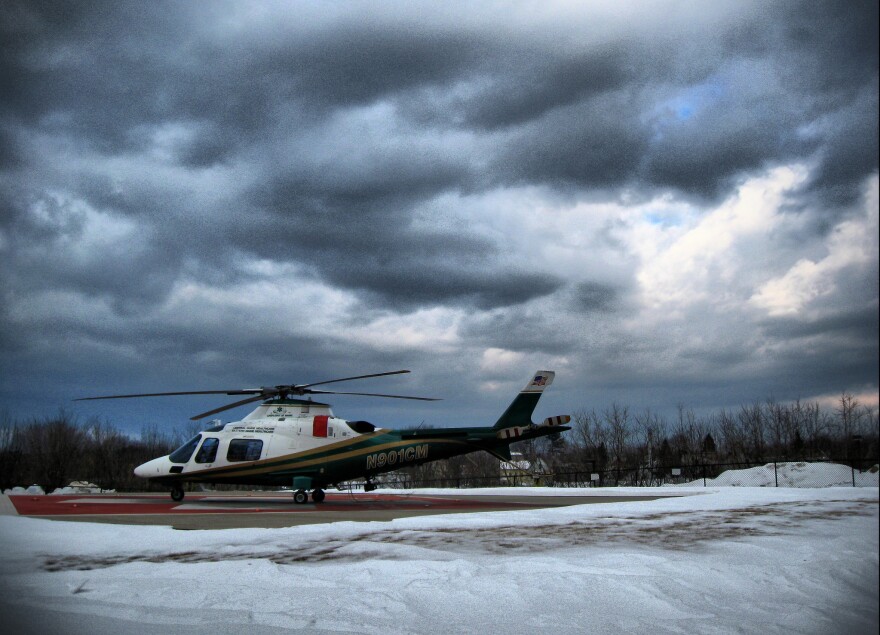LifeFlight helicopters and planes bring patients to the critical care they need when ground services like ambulances aren’t fast enough or can’t reach remote spaces.
As with so many parts of the health care system, this service is also feeling pressures brought by the spread of the coronavirus.
LifeFlight of Maine Executive Director Tom Judge spoke with Morning Edition host Irwin Gratz, and says the pandemic hasn’t increased the number of transports made by the service. But the viral spread does strain the system and the people.
This interview has been edited for clarity.
Judge: This is a complex illness. And so if you have a cardiac condition, it may be related to COVID. It’s a complex disease process. And it impacts what we would generally see for critical patients. And then obviously, for everybody in emergency medicine, especially, it adds a layer of uncertainty. Is this just someone having a heart attack? Or are they having a heart attack that’s related to COVID. And now I have the potential of an infectious disease on top of their heart attack or stroke.
Gratz: Does it pose any particular strain on the people who are caring for the patients that you’re transporting?
Every health care worker in this country, but certainly all of us, are fatigued. This adds a huge amount of pressure on top of an already complicated job. And that’s the same for everybody in every ambulance, emergency department, ICU. But certainly for our people, it’s an added layer of — you have to think every single incident not just about the disease in front of you, but about the potential for infectious contagion in front of you at the same time, while we’re working in a small space at 150 mph.
So this is not proving to be a capacity problem in terms of having enough equipment to make the flights and transport people on a timely basis?
Since this all started in March, we’ve transported 1,768 patients. About 31% of those patients, in August, were known probable or presumed to have potential COVID or known COVID. It’s 74% of the patients in December. Looking at Tuesday, the LifeFlight crews were out 10 times on Tuesday. Three of those patients were motor vehicle crashes — uncertain, no way to tell what’s going on, but we’ve had trauma victims with COVID. Three of those patients were absolutely COVID. And four of those patients had symptoms that could be COVID.
What has it meant for your aircrews and the people who are attending to the patients that they’re now transporting people who are potentially infectious?
Think of this from a system safety standpoint. We’ve added decontamination systems and UV lights and all these series of protective actions together and put that on top of critical care medicine. I still have to treat the patient with sepsis, I still have to treat the person with a stroke or a heart attack or respiratory failure. Whatever that disease process is, this gets layered on top.
So far, you’ve had pretty good luck, I take it?
Luck is a lot of being prepared, right? The crews have worked incredibly diligently, and we have to do this, but our risk is at home. We haven’t had a patient-to-medical-crew exposure, and we’ve had no medical-crew-to-patient exposure. On the other hand, we have seen this come from home, and that’s a challenge for us. And we’ve had to narrow in, increase our vigilance, make sure our people are healthy. But that has been a challenge.
You mentioned earlier the kind of stress of dealing with patients who may now be in some way sicker or present more complex issues. Talk a little bit about the stress that your crews are under, and are you taking any extra steps to help them mentally stay focused?
Part of it is sometimes slowing down a little bit and catching a breath. Obviously patients always come first in a way. But what we’re really saying now is we need to protect the providers, the providers need to protect each other, they need to protect their family. And if we can do those three things, then we know we can protect patients. I think that if we look around the world, I don’t think we begin to understand the emotional and psychological toll that this disease has taken on the health care workforce.
We’ll get through this together. Early on in the pandemic, people didn’t want to go to the hospital for having chest pain. And we saw tragedies from that — people literally die before they reach for help. The hospitals are absolutely safe. If you have a problem, call 911. But in the meantime, protect each other, watch your distance and your symptoms. If we can do those every day, we can keep our schools open, we can get the economy going. And Maine will be safe.



